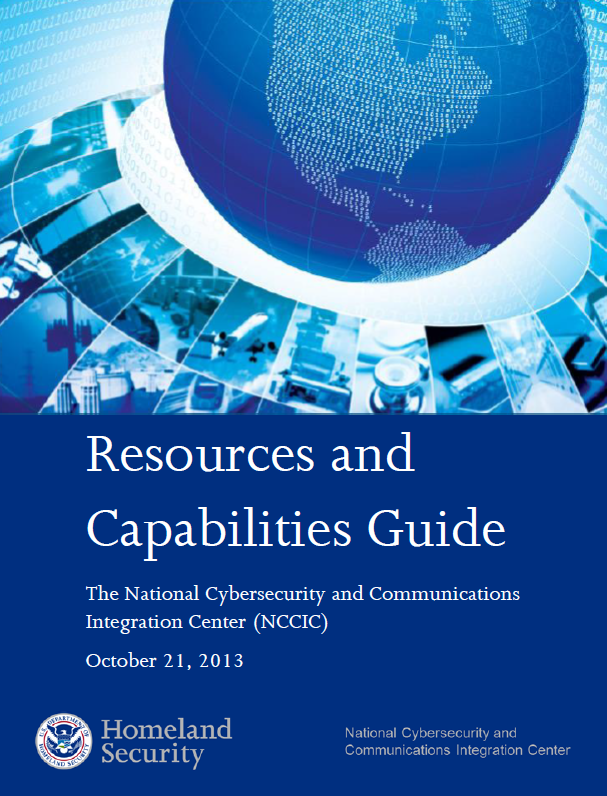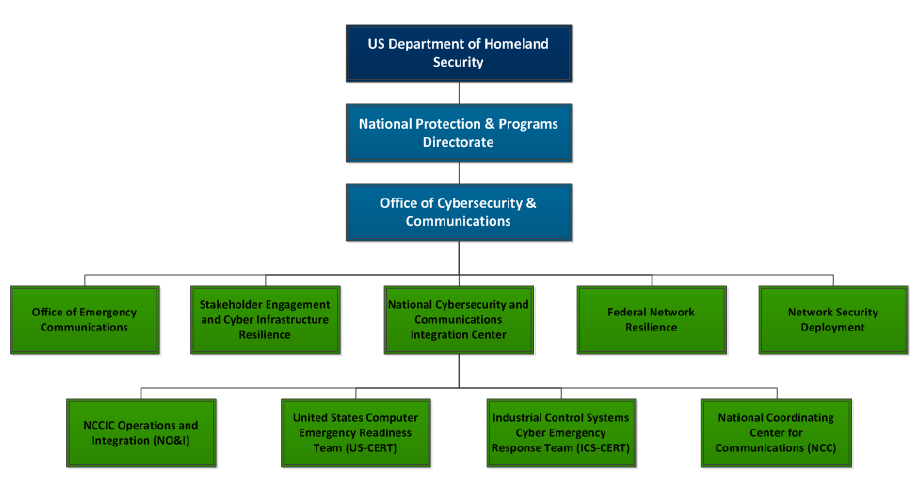The following capabilities guide for the Department of Homeland Security’s National Cybersecurity and Communications Integration Center (NCCIC) was released publicly by the U.S. Fire Administration in a recent issue of their Emergency Management & Response-Information Sharing & Analysis Center newsletter.
National Cybersecurity and Communications Integration Center (NCCIC) Resources and Capabilities Guide
- 37 pages
- For Official Use Only
- October 21, 2013
The National Cybersecurity and Communications Integration Center (NCCIC) Resource and Capabilities Guide is intended to enhance cross-sector cyber security efforts and collaboration by better informing our cybersecurity and communications partners of the NCCIC’s tools, assets, and collaboration mechanisms offered. This guide also identifies the Center’s resources and capabilities as well as describes the processes for accessing NCCIC information portals and products, incident reporting systems, and relevant point of contact information for our community of partners.
…
The Department of Homeland Security (DHS) is responsible for protecting the Nation’s critical infrastructure from physical and cyber threats. Cyberspace has united once distinct information structures, including business and government operations, emergency preparedness communications, and critical digital and process control systems and infrastructures. Protection of these systems is essential to the resilience and reliability of the Nation’s critical infrastructure and key resources (CIKR) affecting economic and national security.
NCCIC Overview
The National Cybersecurity & Communications Integration Center (NCCIC), within the Office of Cybersecurity and Communications (CS&C) (http://www.dhs.gov/office-cybersecurity-and-communications), serves as a centralized location where operational elements are coordinated and integrated. NCCIC partners include all federal departments and agencies; state, local, tribal, and territorial (SLTT) governments; the private sector; and international entities. The NCCIC’s activities include providing greater understanding of cybersecurity and communications situation awareness vulnerabilities, intrusions, incidents, mitigation, and recovery actions.
NCCIC Vision
A world class cybersecurity and communications organization performing cutting edge analysis, sharing actionable and comprehensive information in real time, and ensuring a whole-of-nation approach to response, mitigation, and recovery efforts.
NCCIC Mission
To operate at the intersection of the private sector, civilian, law enforcement, intelligence, and defense communities, applying unique analytic perspectives, ensuring shared situational awareness, and orchestrating synchronized response efforts while protecting the Constitutional and privacy rights of Americans in both the cybersecurity and communications domains.
The NCCIC’s missions include:
– Protection of federal civilian agencies in cyberspace;
– Working closely together with critical infrastructure owners/operators and sector specific agencies to reduce risk;
– Collaborating with state and local governments through the Multi-State Information Sharing and Analysis Center (MS-ISAC);
– Cooperating with international partners to share information and respond to incidents;
– Coordinating national response to significant cyber incidents in accordance with the National Cyber Incident Response Plan (NCIRP);
– Analyzing data to develop and share actionable mitigation recommendations;
– Creating and maintaining shared situational awareness among its partners and constituents;
– Orchestrating national protection, prevention, mitigation, and recovery activities associated with significant cyber and communication incidents;
– Disseminating cyber threat and vulnerability analysis information; and
– Assisting in the initiation, coordination, restoration, and reconstitution of National Security or Emergency Preparedness (NS/EP) telecommunications services and facilities under all conditions, crises, or emergencies, including executing Emergency Support Function 2- Communications (ESF-2) responsibilities under the National Response Framework (NRF).The NCCIC is comprised of four branches:
– NCCIC Operations & Integration (NO&I);
– United States Computer Emergency Readiness Team (US-CERT);
– Industrial Control Systems Cyber Emergency Response Team (ICS-CERT); and
– National Coordinating Center (NCC) for Communications.As mutually supporting, fully integrated elements of the NCCIC, these branches provide capabilities and partnerships necessary to lead a whole-of-nation approach to addressing cybersecurity and communications issues at the operational level.
…


